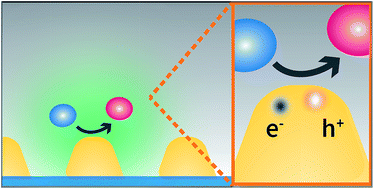当前位置:
X-MOL 学术
›
Faraday Discuss.
›
论文详情
Our official English website, www.x-mol.net, welcomes your
feedback! (Note: you will need to create a separate account there.)
Monitoring plasmonic hot-carrier chemical reactions at the single particle level
Faraday Discussions ( IF 3.3 ) Pub Date : 2018-10-24 , DOI: 10.1039/c8fd00138c Sabrina Simoncelli 1, 2, 3, 4, 5 , Evangelina L. Pensa 1, 2, 3, 4, 5 , Thomas Brick 1, 2, 3, 4, 5 , Julian Gargiulo 1, 2, 3, 4, 5 , Alberto Lauri 1, 2, 3, 4, 5 , Javier Cambiasso 1, 2, 3, 4, 5 , Yi Li 1, 2, 3, 4, 5 , Stefan A. Maier 1, 2, 3, 4, 5 , Emiliano Cortés 1, 2, 3, 4, 5
Faraday Discussions ( IF 3.3 ) Pub Date : 2018-10-24 , DOI: 10.1039/c8fd00138c Sabrina Simoncelli 1, 2, 3, 4, 5 , Evangelina L. Pensa 1, 2, 3, 4, 5 , Thomas Brick 1, 2, 3, 4, 5 , Julian Gargiulo 1, 2, 3, 4, 5 , Alberto Lauri 1, 2, 3, 4, 5 , Javier Cambiasso 1, 2, 3, 4, 5 , Yi Li 1, 2, 3, 4, 5 , Stefan A. Maier 1, 2, 3, 4, 5 , Emiliano Cortés 1, 2, 3, 4, 5
Affiliation

|
Plasmon excitation in metal nanoparticles triggers the generation of highly energetic charge carriers that, when properly manipulated and exploited, can mediate chemical reactions. Single-particle techniques are key to unearthing the underlying mechanisms of hot-carrier generation, transport and injection, as well as to disentangling the role of the temperature increase and the enhanced near-field at the nanoparticle–molecule interface. Gaining nanoscopic insight into these processes and their interplay could aid in the rational design of plasmonic photocatalysts. Here, we present three different approaches to monitor hot-carrier reactivity at the single-particle level. We use a combination of dark-field microscopy and photoelectrochemistry to track a hot-hole driven reaction on a single Au nanoparticle. We image hot-electron reactivity with sub-particle spatial resolution using nanoscopy techniques. Finally, we push the limits by looking for a hot-electron induced chemical reaction that generates a fluorescent product, which should enable imaging plasmonic photocatalysis at the single-particle and single-molecule levels.
中文翻译:

在单个粒子水平上监测等离子体热载体化学反应
金属纳米粒子中的等离子激发触发了高能电荷载体的生成,这些电荷载体经过适当的操纵和利用,可以介导化学反应。单颗粒技术是揭示热载流子产生,运输和注入的基本机制,以及解开温度升高和纳米颗粒-分子界面增强近场作用的关键。深入了解这些过程及其相互作用可有助于合理设计等离激元光催化剂。在这里,我们提出了三种不同的方法来监控单粒子水平上的热载流子反应性。我们结合使用暗场显微镜和光电化学技术来跟踪单个Au纳米粒子上的热孔驱动反应。我们使用纳米技术将热电子反应性与亚粒子空间分辨率成像。最后,我们通过寻找产生荧光产物的热电子诱导的化学反应来突破极限,这应该能够在单粒子和单分子水平上实现等离激元光催化成像。
更新日期:2019-05-29
中文翻译:

在单个粒子水平上监测等离子体热载体化学反应
金属纳米粒子中的等离子激发触发了高能电荷载体的生成,这些电荷载体经过适当的操纵和利用,可以介导化学反应。单颗粒技术是揭示热载流子产生,运输和注入的基本机制,以及解开温度升高和纳米颗粒-分子界面增强近场作用的关键。深入了解这些过程及其相互作用可有助于合理设计等离激元光催化剂。在这里,我们提出了三种不同的方法来监控单粒子水平上的热载流子反应性。我们结合使用暗场显微镜和光电化学技术来跟踪单个Au纳米粒子上的热孔驱动反应。我们使用纳米技术将热电子反应性与亚粒子空间分辨率成像。最后,我们通过寻找产生荧光产物的热电子诱导的化学反应来突破极限,这应该能够在单粒子和单分子水平上实现等离激元光催化成像。











































 京公网安备 11010802027423号
京公网安备 11010802027423号